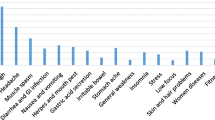Abstract
Background Self-medication refers to using drugs which have not been prescribed, recommended or controlled by a licensed health care specialist. Marketing, in Chile only admitted for over-the-counter medications, influences the practice of self-medication and extends it to prescription drugs. Thus, a complex self-medication process is started, due to reuse of a previous prescription, using drugs purchased directly at the pharmacy or drugs coming from family first-aid kits. The purpose of this study is to determine the frequency of self-medication, the type of medications involved, the dosages used, and the reasons for this practice. Methods An observation-based cross-sectional study was carried out at three pharmacies belonging to a pharmacy chain in the city of Valdivia (southern Chile). In addition, a previously validated form was used. Customers who requested over-the-counter medications were surveyed to identify the patterns that foster the self-medication practice. Results Of 909 surveyed customers, 75% self-medicate. Of these, 31% stated that they commonly self-medicate due to suffering from light symptoms, such as headaches (19%), the common cold (8.8%), sore muscles (6.7%), and bone pains (5.3%). The group of medications most requested in this study was nonsteroidal anti-inflammatory drugs (NSAIDs) (33%), with diclofenac sodium being the most used (14%). Influence from other people did not exceed 20% and reusing prior prescriptions reached 46%. There were significant differences when assessing consumer knowledge, reading of information leaflets, and opinions about self-medication at each surveyed pharmacy (P < 0.001). Conclusion Most consumers at the surveyed pharmacies use medications without proper knowledge of their benefits, treatment method, and duration. Drug dispensing at community pharmacies should include active pharmacist involvement to divulge the sensible use of drugs.
Similar content being viewed by others
References
Alfonso GT. El Rol del Farmacéutico en Automedicación. Uso de Medicamentos: análisis desde la Experiencia en España (The Role of the Pharmacist in self-medication. Using Drugs: analysis from the experience in Spain). Pharm Care. 1999;1:157–64.
González J. Martín, E. Ruiz, D. Arrebola, M. De la Cruz, P. Ética de la prescripción. Perspectivas desde la atención primaria (Ethics prescription. Perspectives from primary care). Farmacoterapia. 2004;2(4):247–57.
Promoción del uso racional de medicamentos: componentes centrales. Perspectivas políticas sobre medicamentos de la OMS. (Rational use of medicines: central components. WHO drugs policies) Ginebra. 2002.
Multicenter study on self-medication and self-prescription in six Latin American countries. Drug Utilization Research Group, Latin America. Clin Pharmacol Ther. 1997;61(4):488–93. doi:10.1016/S0009–9236(97)90199-5.
Danhier A, Brieva J, Villegas G, Yates T, Perez H, Boggiano G. Use of drugs in an urban population. Rev Med Chil. 1991;119(3):334–7.
Hong SH, Spadaro D, West D, Tak SH. Patient valuation of pharmacist services for self care with OTC medications. J Clin Pharm Ther. 2005;30(3):193–9. doi:10.1111/j.1365-2710.2005.00625.x.
Wazaify M, Shields E, Hughes CM, McElnay JC. Societal perspectives on over-the-counter (OTC) medicines. Fam Pract. 2005;22(2):170–6. doi:10.1093/fampra/cmh723.
Guidelines for the medical assessment of drugs for use in self-medication. World Health Organization (Regional Office for Europe). Copenhagen. 1986.
Baos V. Estrategias para Reducir los Riesgos de Automedicación (Strategies to reduce the risk of self-medication). Informacion Ter Sistema Nac Salud Madr. 2000;24:147–52.
Sinclair HK, Bond CM, Hannaford PC. Long term follow-up studies of users of nonprescription medicines purchased from community pharmacies: some methodological issues. Drug Saf. 2001;24:929–38. doi:10.2165/00002018-200124120-00006.
Nunes de Melo M, Madureira B, Nunes Ferreira AP, Mendes Z, Miranda Ada C, Martins AP. Prevalence of self-medication in rural areas of Portugal. Pharm World Sci. 2006;28(1):19–25. doi:10.1007/s11096-005-2222-y.
Bastante T, De la Morena F. Automedicación en Población Universitaria, Universidades Autónoma, Complutense y Carlos III de Madrid, España. [Self-medication in the University population] Madrid. 2000.
Tobon F. Estudio sobre automedicación en la Universidad de Antioquía (Study about self-medication at the University of Antioquía), Medellín, Colombia. IATREIA. 2002;15(4):242–7.
Smalley WE, Griffin MR. The risks and costs of upper gastrointestinal disease attributable to NSAIDs. Gastroenterol Clin North Am. 1996;25:373–96. doi:10.1016/S0889-8553(05)70253-3.
Wolfe M, Lichtenstein D, Singh G. Medical progress: gastrointestinal toxicity of nonsteroidal antiinflamatory drugs. N Engl J Med. 1999;340:1888–99. doi:10.1056/NEJM199906173402407.
Singh G, Ramey DR. NSAID-induced gastrointestinal complications: the ARAMIS perspective-1997. J Rheumatol. 1998;25(suppl 51):8–16.
Richy F, Bruyere O, Ethgen O, Rabenda V, Bouvenot G, Audran M, et al. Time dependent risk of gastrointestinal complications induced by non-steroidal anti-inflammatory drug use: a consensus statement using a meta-analytic approach. Ann Rheum Dis. 2004;63:759–66. doi:10.1136/ard.2003.015925.
Laporte JR. Automedicación: ¿la información de los usuarios aumenta al mismo tiempo que el consumo? (Self-medication: is the user information increasing consumption?) Med Clin (Barc). 1997;109:795–6.
Vanin JR, Saylor KE. Laxative abuse: a hazardous habit for weight control. Coll Health. 1989;37:227–30.
Fleming GF, McElnay JC, Hughes CM. Development of a community pharmacy-based model to identify and treat OTC drug abuse/misuse: a pilot study. Pharm World Sci. 2004;26(5):282–8. doi:10.1023/B:PHAR.0000042891.66983.60.
Edmeads JG, Gawel MJ, Vickers J. Strategies for diagnosing and managing medication-induced headache. Can Fam Physician. 1997;43:1249–54.
Riedemann J, Illesca M, Droghetti J. Automedicación en individuos de la Región de la Araucanía con problemas musculoesqueléticos (Self medication among patients with musculoskeletal symptoms), Chile. Rev Med Chil. 2001;129:647–52.
Huber W. Uso racional de medicamentos: encuesta a directores técnicos de farmacias de la Región Metropolitana, V Región, (Rational use of drugs: survey to pharmacy directors of the Metropolitan Region) Zona Norte y Zona Sur de Chile. Pharmakon. 2005;9:11–4.
Acknowledgements
Thanks are extended to the pharmacy chain Salcobrand in the City of Valdivia for allowing us to use their facilities during the research.
Funding
This research was financed by the Pharmacy School of the Facultad de Ciencias of the Universidad Austral de Chile.
Conflicts of interest
There are no conflicts of interest.
Author information
Authors and Affiliations
Corresponding author
Rights and permissions
About this article
Cite this article
Fuentes Albarrán, K., Villa Zapata, L. Analysis and quantification of self-medication patterns of customers in community pharmacies in southern Chile. Pharm World Sci 30, 863–868 (2008). https://doi.org/10.1007/s11096-008-9241-4
Received:
Accepted:
Published:
Issue Date:
DOI: https://doi.org/10.1007/s11096-008-9241-4




